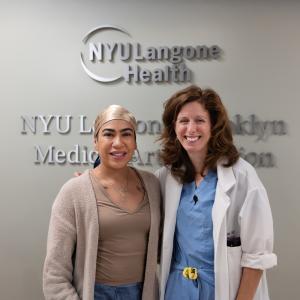
Experts at Rusk Rehabilitation at NYU Langone Hospital—Brooklyn work with patients before and after joint replacement surgery to expedite discharge.
Photo: Karsten Moran
Same-day discharge (SDD) joint replacement is becoming increasingly popular among patients and providers across the country, driven by demographic, economic, and epidemiological forces. At Rusk Rehabilitation at NYU Langone Hospital—Brooklyn, careful preoperative preparation and aggressive postoperative follow-up help ensure quality outcomes in this new model of care.
The Advantages of Same-Day Discharge
Over the past decade, multiple studies have demonstrated that in properly selected patients, SDD total hip and knee arthroplasty can provide outcomes similar to those of inpatient surgery—with improved patient satisfaction, decreased perioperative morbidity, and reduced costs. As the U.S. population ages, and as healthcare evolves toward a value-based model, such procedures are being offered at a growing number of medical centers. And since the onset of the coronavirus (COVID-19) pandemic, with concern over infection spurring patients to avoid inpatient stays, demand for SDD procedures has risen sharply.
Five years ago, NYU Langone became the first medical center in New York City to offer SDD hip replacement, in collaboration with Rusk Rehabilitation; SDD knee replacement followed shortly thereafter.
In early 2020, the SDD program expanded to NYU Langone Hospital—Brooklyn, again operating in tandem with Rusk Rehabilitation. The new program, like its predecessor, owes much of its success to skilled surgeons leveraging state-of-the-art technologies. Yet what happens before and after each procedure is crucial as well—in particular, the pre- and postsurgical care delivered by Rusk Rehabilitation’s physical therapy team.
The team is led by Manuel Wilfred, DPT, PhD, assistant supervisor at Rusk Rehabilitation at NYU Langone Hospital—Brooklyn, and works closely with Joshua C. Rozell, MD, assistant professor in the Department of Orthopedic Surgery, who heads the hospital’s SDD program. Rusk Rehabilitation experts play a central role in ensuring that each patient is well prepared for surgery, recovers swiftly, and regains full mobility.
Laying the Groundwork for Optimal Outcomes
In Brooklyn, many patients live alone or face other obstacles to safe early discharge, such as walk-up apartment buildings, language barriers, or lack of insurance access—one reason why few surgeons in the borough provide SDD joint replacement. The goal of the NYU Langone Hospital—Brooklyn program is to make such procedures available to anyone who can safely benefit. Patients are selected carefully on the basis of factors including overall health, activity level, motivation to pursue postoperative rehabilitation, and access to social support during recovery.
A Rusk Rehabilitation clinical care coordinator discusses expectations and discharge plans with the patient before surgery, arranging home therapy in advance. During the preoperative consultation, Dr. Rozell provides the patient with a “playbook” containing detailed instructions on how to prepare for the procedure as well as information on rehabilitation, the recovery timeline, and potential postsurgical issues.
The Importance of Early Postoperative Intervention
Dr. Rozell uses a variety of advanced surgical techniques to facilitate same-day discharge and faster recovery. For the knee, he relies on a tourniquet-less, computer-navigated procedure that helps to accurately restore leg alignment while reducing postsurgical muscle dysfunction. For the hip, he typically performs an anterior approach that spares soft tissues, facilitates intraoperative imaging and accurate implant placement, and improves clinical assessment of leg length. Another key element is the use of a short-acting spinal anesthetic rather than general anesthesia.
Rusk Rehabilitation physical therapists start the rehabilitation process for SDD patients just 90 minutes after surgery as the spinal block begins to wear off. “In the past, we used to let patients rest all day, and we’d start working with them the next morning,” Wilfred says. “Now we have them sit up as soon as possible, while they’re still in the recovery room. We make sure their blood pressure and other vitals are good and that they’ve got normal function in their limbs. Then we try to get them ambulating. With help, some patients can walk 50 to 60 feet 2 hours after the surgeon places the last stitch.”
Later in the day, the Rusk Rehabilitation experts return for a second session that typically includes stair-climbing practice. Throughout the process, they consult electronically with other members of the multidisciplinary care team—including Dr. Rozell, physician assistants, case managers, nurses, and social workers—to report on the patient’s status and arrange for any special equipment or treatments that might be needed going forward. In the majority of cases, discharge occurs that evening.
Supported Discharge Brings Faster Recovery
Home physical therapy is initiated about 24 hours later, progressing to outpatient physical therapy once the patient is able to travel to a clinic unaided. “This is very much a supported discharge,” Wilfred notes. “It’s made possible only by the highest level of coordination among providers who are all focused on the same goal for our patients.”
Altogether, the course of rehabilitation for NYU Langone’s Brooklyn patients (as for their Manhattan counterparts) is typically shorter than for those who receive inpatient joint replacement, with fewer complications and readmissions. “With early, aggressive, and well-orchestrated intervention, we’ve improved outcomes while carving out days or weeks from the length of recovery,” Wilfred says.
“None of our patients have had any complaints,” he adds. “In fact, many of them have asked to come back for the other side to be done.”

